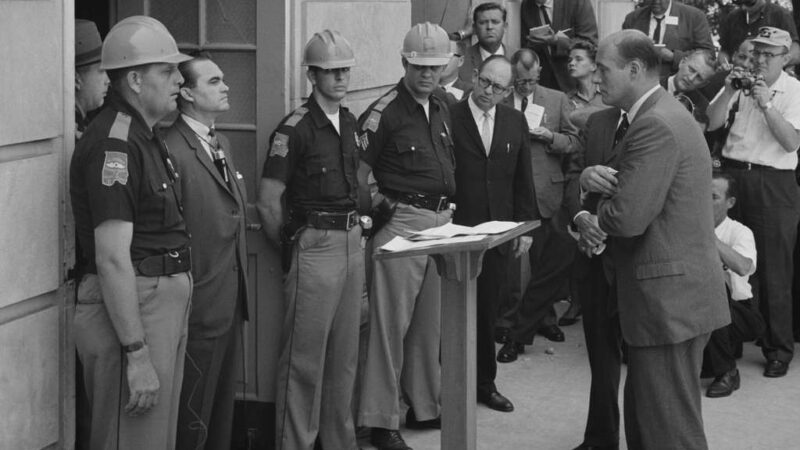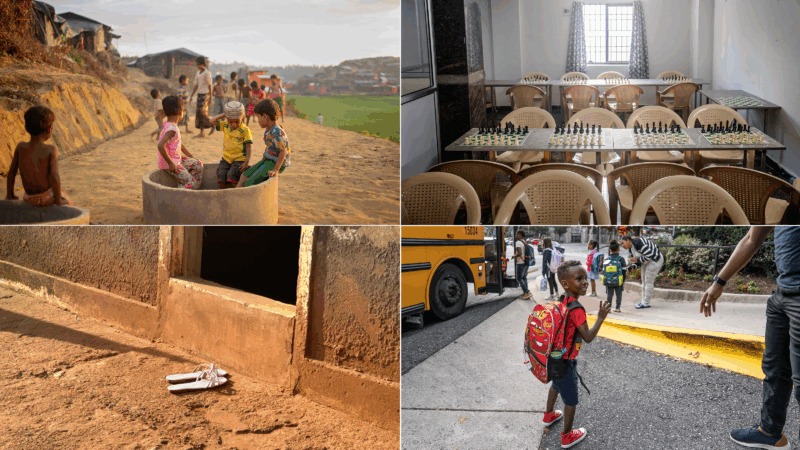Katrina-Alabama schools
But some of these same kids – here and at other evacuation shelters in north central Alabama — will be stepping to the beat of a different drum very soon. They, and their parents, are making the transition from evacuees of New Orleans or Mississippi to temporary residents of Alabama.
And that requires parents to enroll them in school… school that’s already started. School systems that are hundreds of miles from home.
10-year old 4th grader Rashana Williams taps her feet to the beat as she looks on, still dazed – and quiet — from a week of monumental movement and displacement.
“(You gonna go to school here in Birmingham? Yeah. Are you looking forward to it? You think you’ll like it here?) Yeah.
Her mom, Melissa Williams, says their home in Orleans Parish, Louisiana is gone.
“Everything was destroyed (So you’re going to be here a few months.) Yeah. We was riding to – Florida. But so happened that we stopped in Birmingham and the people were so nice to us and all, we decided to stay.”
She says they’ll be in Birmingham for a few months and in the meantime, they’ll be enrolling Reshana in school.
So far, more than 300 students have enrolled in Birmingham area school systems.
“…we’re used to responding to people in need and helping our neighbors out in Jefferson County.
Dr. Pam Weed is Director of Student Services for Jefferson County schools. She says her school system has responded before to people affected by natural disasters – namely, the F5 tornado that destroyed Oak Grove High School in 1998.
“And I think that that has helped us in this situation be able to deal with and be respectful of the people who are coming… and who’ve also been displaced, because we know what it feels like, to be displaced.”
Weed says Jefferson County schools expect more than 100 enrollee by the time new registration wanes.
In other areas, the situation, and the stories, are the same. 38-year old Starr Rooney and her family from Mandeville, Louisiana escaped the devastation when the warnings of a category five storm came blaring on the radio the Sunday before Katrina hit.
“We just threw some clothes in a bag and we said we’re going to go up north – we didn’t actually know where we were going. We were following a friend of ours and we went to their mother-in-law’s house We stayed there a couple of days and then got in touch with some really great friends of ours.”
Those friends are the Conn’s. They live in Hoover. And now so do the Rooney’s. The Rooney’s are luckier than most: they can probably salvage and return to their suburban New Orleans home. But it’ll take months for repairs to be made to their home. And that means the Rooney’s had to make a decision about what to do with their four school-age kids.
“I wasn’t going to put the kids in school I was hoping – still had that hope that we would be able to go back next week or two and it just doesn’t seem that way and so you really have to step forward and continue to live your life… and our children are most important that they stay in an environment that they’re used to.”
The circumstances of the Rooney’s displacement – and the displacement of thousands of Katrina evacuees in Alabama — mean otherwise stringent registration rules are being brushed aside for now.
In an email message sent to every school system in Alabama – state school superintendent Dr. Joe Morton made it clear that students be admitted to Alabama schools even without proper immunization or medical forms. The memo cites the federal McKinney-Vento Act, which ensures educational rights and protections for homeless children. It is a law that requires schools to remove barriers to enrollment and attendance.
But one thing the school systems are making sure: is that evacuees reside within their districts. And in the ebb and flow of finding new homes or temporary shelter, those who fled the storm have a better chance of going from place to place to place.
“You know the residency could move around.”
Hoover City Schools spokesman Pat Morrow says because of Katrina, residence is loosely defined.
“…when I say residence, I’m not speaking of just a house, obviously we can be talking about staying at a church, they may have an apartment that they just rented, they may be staying at the Holiday Inn. But so long as they are able to show us their intention of a residency and that there’s some documentation that would indicate where they are. If it’s within the borders of Hoover, then they’re certainly welcome at Hoover City Schools.”
Morrow says Hoover schools have had more than 70 enrollments in the past week alone and more are expected. In Birmingham, schools officials counted more than 100 this week.
Jefferson County’s Dr. Pam Weed says her system, and most, will adapt to the influx of new students. Many will be temporary, some will stay for a while. But she says in a crisis of Katrina’s magnitude, what’s a handful more students to help families get their lives back in order.
“Schools are crowded, but everybody’s schools are crowded. We’re short on books and paper – but everybody’s in that same situation. But we’re gonna make it. We’re gonna make it. We’ve got several procedures in place for enrollment that will ease the transition for students. And I think to me the worst ones are the seniors.”
Seniors – she says — who are unsure of their scholastic future, who in many cases lost their high school and are unsure of what to do after they graduate… from a school that up until last week, they had no idea existed.
How Alabama Power has left the ‘American Amazon’ at risk
As its polluting coal ash ponds remain in groundwater, Alabama Power has doubled down on fossil fuel energy investments.
Federal appeals court judge is accused of bullying her clerks
The Legal Accountability Project complaint, which has not been previously reported, states that it is based on conversations with multiple former law clerks.
How George Wallace and Bull Connor set the stage for Alabama’s sky-high electric rates
After his notorious stand in the schoolhouse door, Wallace needed a new target. He found it in Alabama Power.
FIFA president defends World Cup ticket prices, saying demand is hitting records
The FIFA President addressed outrage over ticket prices for the World Cup by pointing to record demand and reiterating that most of the proceeds will help support soccer around the world.
From chess to a medical mystery: Great global reads from 2025 you may have missed
We published hundreds of stories on global health and development each year. Some are ... alas ... a bit underappreciated by readers. We've asked our staff for their favorite overlooked posts of 2025.
The U.S. offers Ukraine a 15-year security guarantee for now, Zelenskyy says
Ukrainian President Volodymyr Zelenskyy said Monday the United States is offering his country security guarantees for a period of 15 years as part of a proposed peace plan.







